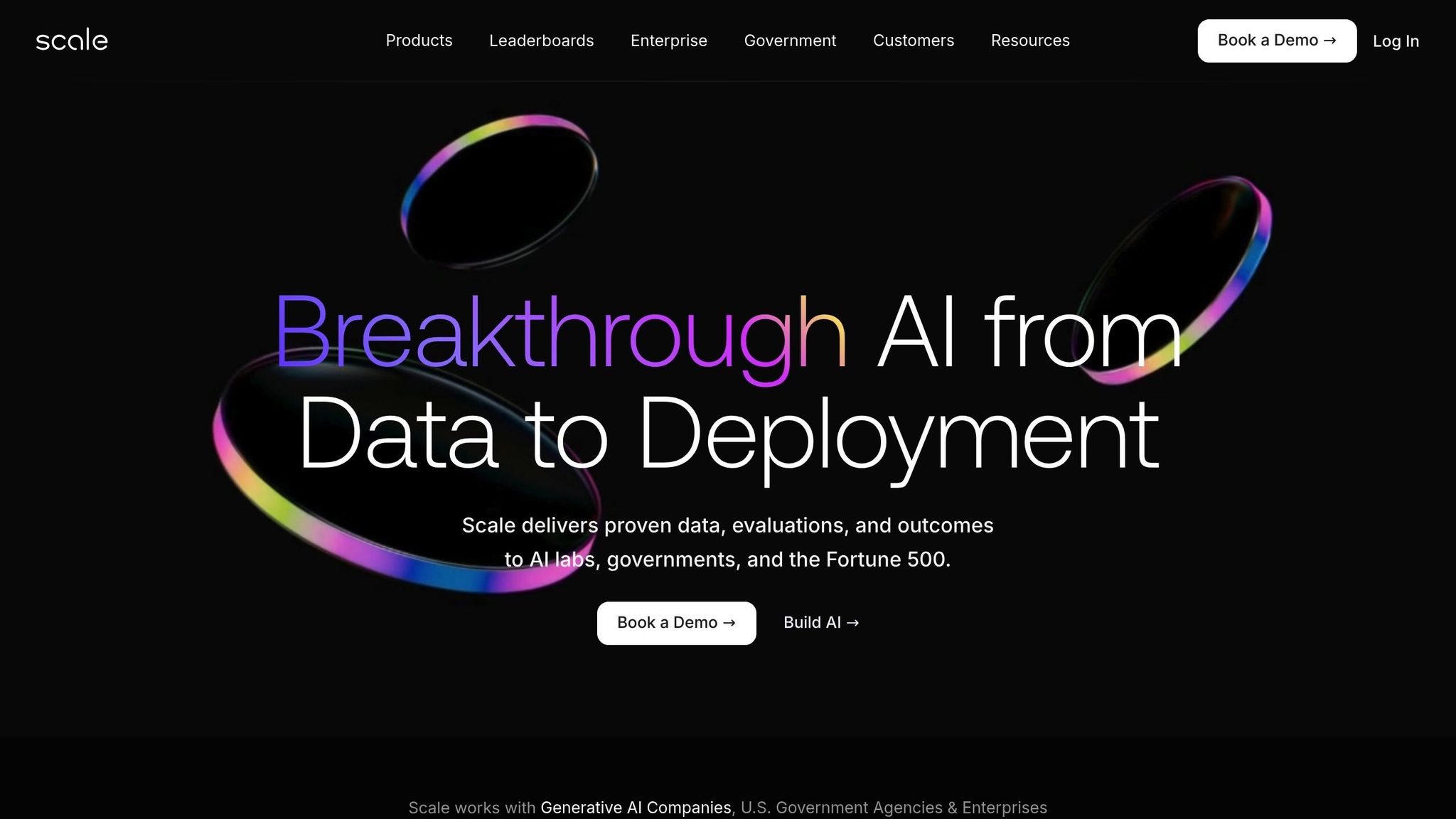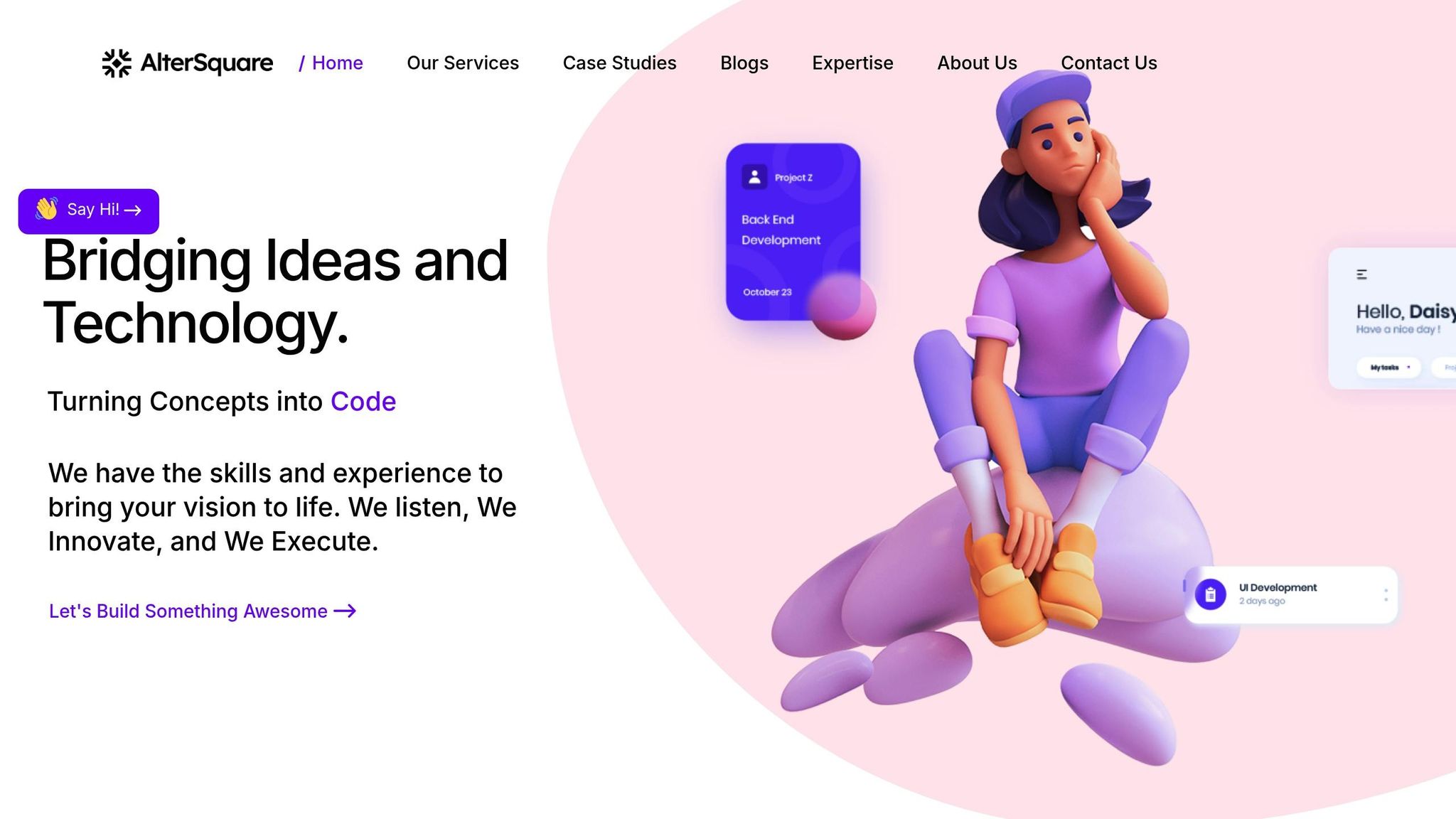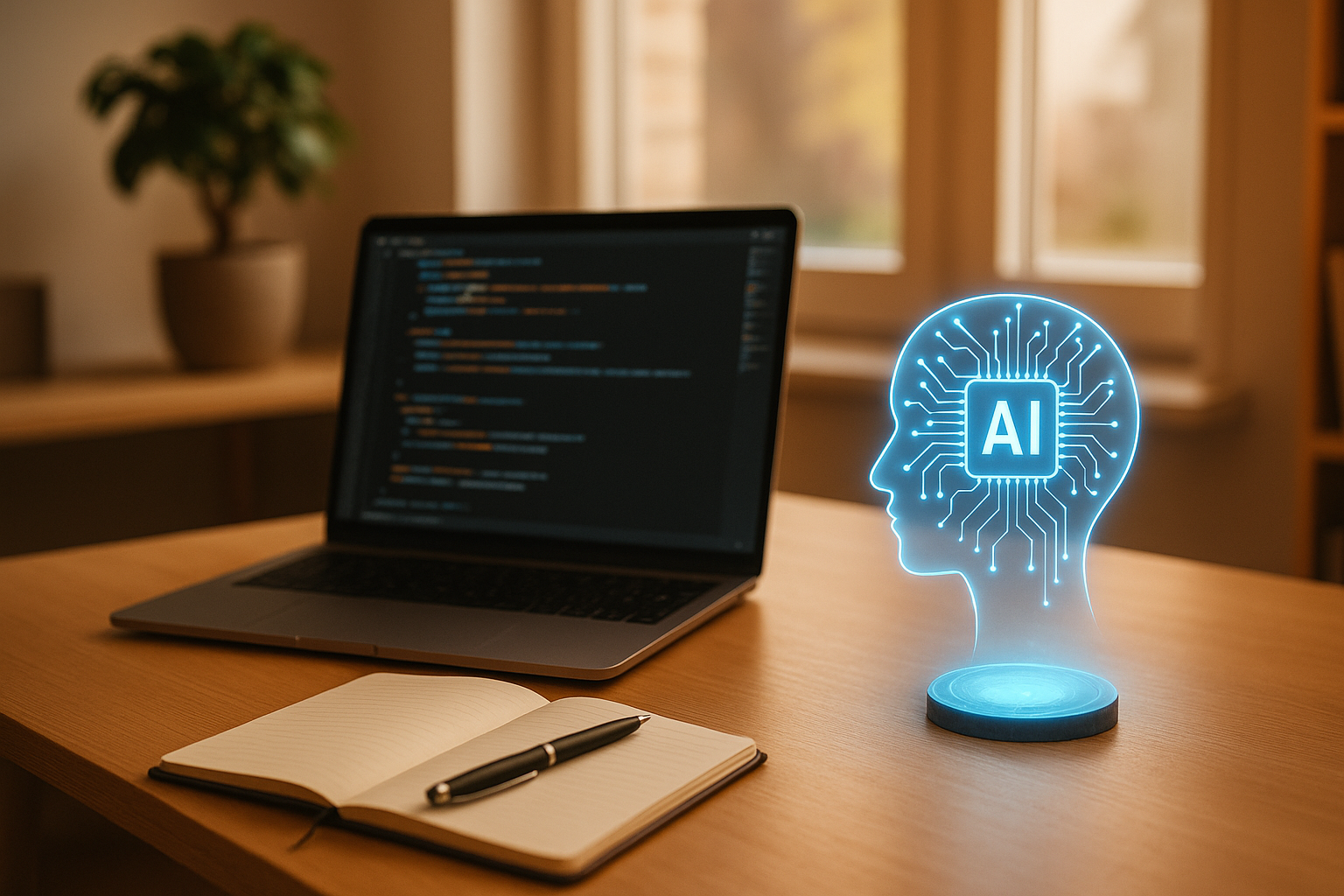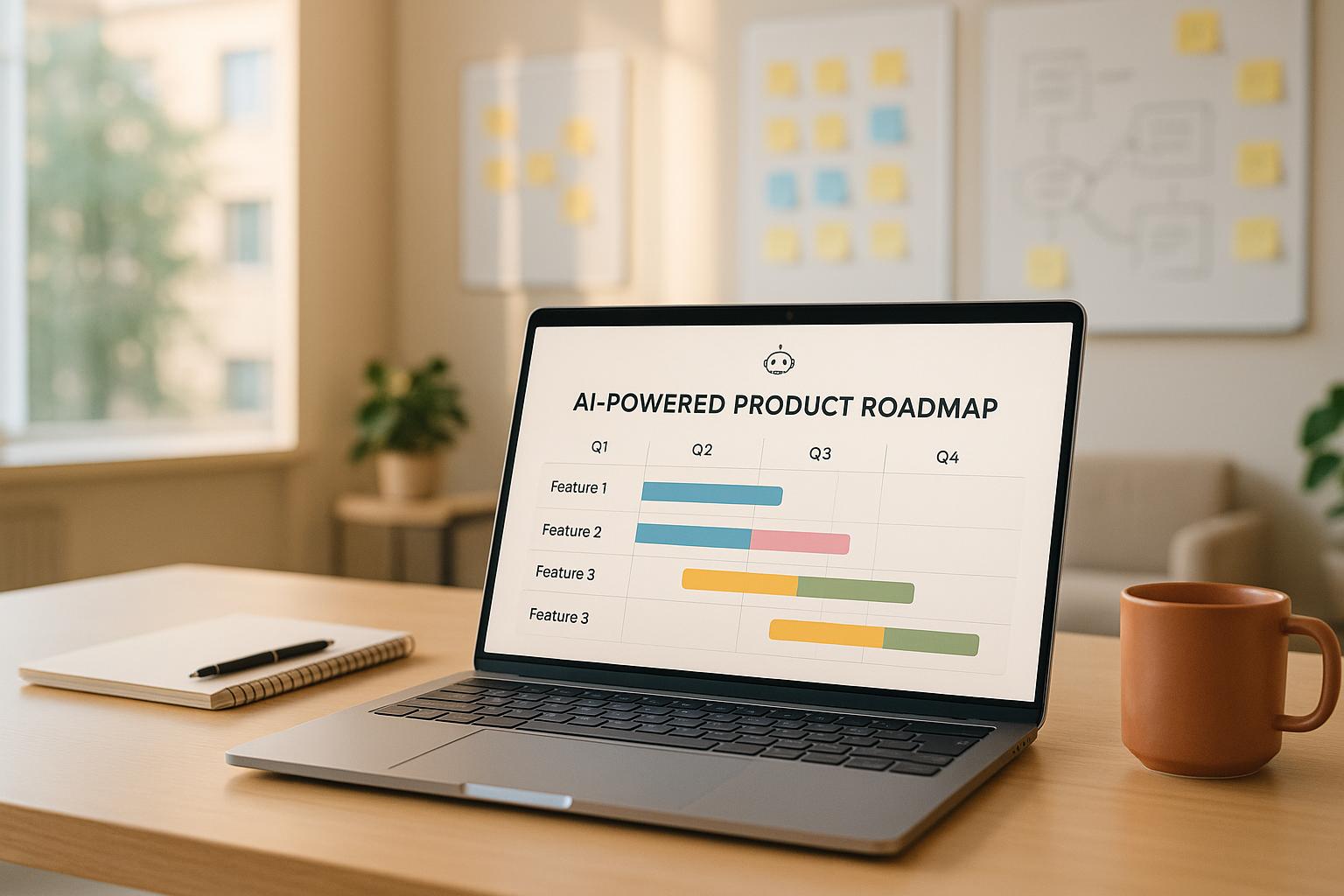Startups thrive when they combine AI tools for speed and automation with human development teams for expertise and problem-solving. Relying solely on AI can lead to issues like poor scalability, security gaps, and limited adaptability to complex needs. On the flip side, depending only on human developers can slow progress and increase costs.
Here’s why the hybrid approach works best:
- AI handles repetitive tasks like prototyping, backend setup, and basic analytics, saving time and reducing costs.
- Human teams focus on complex challenges like system architecture, custom integrations, and long-term scalability.
- Together, they create faster, more reliable workflows that balance speed and quality.
Key benefits of AI tools:
- Accelerates development by automating routine tasks.
- Cuts costs by reducing the need for larger teams.
- Speeds up MVP creation for quicker feedback loops.
Why human teams are critical:
- Ensure code quality, security, and scalability.
- Solve unique problems and manage complex integrations.
- Provide strategic oversight and long-term planning.
The best results come from structured hybrid workflows where AI assists with initial drafts, and humans refine and integrate the output. Startups that embrace this balance can build products faster without sacrificing reliability or growth potential.
From Scale AI to Startup: How AI-Native Teams Are Built

How AI Tools Speed Up Startup Development
AI tools have become a game-changer for startups aiming to move quickly and stay cost-efficient. These tools excel at tackling repetitive tasks that can drain time and resources. By using AI strategically, startups can fast-track their journey from concept to market while keeping expenses in check.
The real strength of AI lies in its ability to automate routine tasks, freeing up human developers to focus on the more complex, high-impact work that demands creativity and expertise. Startups that strike this balance can build momentum faster without compromising quality.
AI Tools for Prototyping and Testing Tasks
One of the most impactful uses of AI in startup development is design prototyping. Tools like GitHub Copilot can quickly generate user interface components, enabling functional prototypes to be created in minutes instead of hours. AI-powered platforms can also produce multiple design variations, giving startups the flexibility to test different ideas without heavy upfront investment in design resources.
AI also shines in backend setup and configuration. It can handle tasks like generating database schemas, API endpoints, and standard CRUD operations based on simple descriptions of application requirements. This eliminates much of the repetitive coding that typically slows down early development stages.
For user testing and analytics, AI tools can process large volumes of feedback data, uncover patterns in user behavior, and generate actionable insights far faster than human analysts. They can categorize user comments, detect sentiment trends, and flag potential usability issues automatically.
Content generation is another area where AI tools save time and effort. Whether it’s drafting marketing copy, creating documentation, or developing user-facing content, AI can produce solid first drafts. While human oversight is still crucial, these tools can significantly reduce the workload, allowing teams to focus on refining and personalizing the output.
These capabilities highlight how AI tools streamline early development tasks, enabling human teams to concentrate on more intricate challenges.
Main Benefits of AI Tools for Startups
The most immediate benefit of AI tools for startups is time savings. Tasks that might take hours for a developer can often be completed by AI in a fraction of the time. This speed is essential when startups need to validate ideas or adapt to market feedback quickly.
Cost savings are another major advantage. By automating repetitive tasks, startups can operate efficiently with smaller teams, extending their financial runway. The cost of AI tools is typically far lower than hiring additional developers to handle the same workload.
AI tools also enable faster MVP validation. By automating the creation of basic functionality, startups can present working prototypes to users much earlier than traditional methods would allow. This quick feedback loop helps refine or pivot ideas before significant resources are invested.
That said, AI tools do have limitations, which startups must consider carefully. Here’s a breakdown of where they excel and where they fall short:
| AI Tool Advantages | AI Tool Limitations |
|---|---|
| Rapid prototype generation | Limited understanding of complex business logic |
| Cost-effective for repetitive tasks | Challenges with custom integrations |
| Always available for development work | Potential gaps in security and compliance |
| Consistent output for routine work | Lack of strategic thinking and architectural planning |
| Scalable development capacity | Struggles with edge cases and error handling |
The scalability of AI tools is particularly valuable for startups experiencing growth. Unlike human teams, AI tools can handle sudden increases in workload – whether it’s generating code, running tests, or creating content – without delays caused by hiring or onboarding.
By understanding these strengths and weaknesses, startups can make better decisions about how to use AI effectively. The goal isn’t to replace human developers but to amplify their abilities, allowing them to focus on the tasks that truly require human creativity and insight. This approach ensures startups can move efficiently without losing the human touch that drives innovation.
Next, we’ll dive into why human development teams remain essential for long-term product success.
Why Development Teams Matter for Long-Term Product Success
AI tools are fantastic for speeding up the early stages of development, but when it comes to creating products that can grow, evolve, and thrive over time, human development teams are indispensable. The leap from a quick prototype to a scalable, sustainable business often hinges on the strategic thinking, technical expertise, and problem-solving abilities that only human developers can bring to the table.
Human developers offer a depth of understanding that AI simply can’t replicate. They evaluate how decisions made today will impact the product in the future, ensuring the foundation is strong enough to support growth and new features. This forward-thinking approach helps avoid costly rewrites and technical missteps down the line.
Another key strength of human developers is their ability to solve complex problems creatively. While AI tools excel at standard tasks, they often fall short when faced with unique challenges or custom requirements. Developers can think outside the box, tailoring solutions to meet specific business needs and market demands.
Tasks That Need Human Expertise
There are certain tasks where human expertise is not just helpful – it’s essential. These areas highlight why development teams remain critical for long-term product success.
Architectural decision-making is one of those areas. Choosing the right database, designing how different system components interact, and planning for scalability are decisions that require both technical know-how and a solid understanding of the business. These choices set the stage for everything that follows, and mistakes here can be costly for a growing startup.
Code quality and maintainability depend heavily on human judgment. Experienced developers don’t just write functional code – they write code that’s easy for others to understand, modify, and expand. They know when to refactor, how to handle errors gracefully, and which coding patterns will stand the test of time.
Complex integrations are another area where human involvement is critical. Whether it’s connecting to third-party services, working with legacy systems, or handling custom APIs, these tasks often involve edge cases and unexpected challenges. Developers bring the adaptability and troubleshooting skills needed to make these integrations work smoothly.
Security implementation is a task that demands human oversight. AI can suggest basic security measures, but experienced developers understand the broader landscape. They can spot vulnerabilities, implement robust security protocols, and stay ahead of emerging threats – all while ensuring the solution balances security with usability.
Finally, performance optimization benefits greatly from human expertise. Developers can identify bottlenecks, fine-tune database queries, and make architectural adjustments to boost system performance. This often involves analyzing user behavior, conducting load tests, and making informed trade-offs to achieve the best results.
Problems with Using Only AI Tools
Relying solely on AI tools might seem tempting, but it comes with significant drawbacks that can hinder a product’s growth and adaptability.
One major issue is technical debt. AI-generated code often prioritizes speed over long-term maintainability. While this might work for a prototype, it becomes a problem as the product grows more complex and requires updates or new features.
Another challenge is the lack of strategic oversight. AI tools can create functional code, but without a unified vision, the codebase can become inconsistent, with redundant features and conflicting architectural decisions.
Error handling and edge case management are also weak points for AI-generated solutions. AI tends to handle common scenarios well but struggles with the unexpected situations that real users often encounter. Human developers anticipate these edge cases and build robust systems that keep applications stable.
Compliance and regulatory requirements pose additional challenges. AI tools don’t inherently understand industry-specific standards like GDPR or accessibility guidelines. Human developers, on the other hand, can ensure these requirements are met from the beginning, avoiding costly compliance issues later.
Finally, integration complexity can spiral out of control when AI tools generate components that don’t work well together. While each piece might function independently, combining them often requires human intervention to resolve conflicts and ensure smooth operation.
AI tools are undeniably valuable, but they’re not a replacement for human expertise. The most successful startups leverage the speed and efficiency of AI while relying on human developers to provide the strategic thinking, adaptability, and quality that drive long-term success. By combining the strengths of both, teams can build products that are not only fast to market but also built to last.
sbb-itb-51b9a02
Building Hybrid Workflows: Combining AI Tools with Development Teams
The magic happens when startups seamlessly integrate AI tools with their development teams, creating workflows where both complement each other. These hybrid workflows rely on well-coordinated processes, where the timing of tasks and smooth handoffs are the backbone of success.
In these workflows, AI takes the lead on generating initial ideas and quick iterations, while humans step in to refine and integrate them into the bigger picture. Startups that excel in this area know how to choreograph these transitions, striking a balance between speed and quality.
Step-by-Step Workflows for AI-Supported Development
To create effective hybrid workflows, startups need a structured plan that leverages the strengths of both AI tools and human expertise. A three-phase approach works well: AI-driven exploration, human-led validation, and collaborative refinement.
Phase 1: AI-Driven Exploration
AI kicks things off by producing wireframes, boilerplate code, database schemas, and design variations. The focus here is on speed and quantity, not perfection. For instance, AI can churn out dozens of options in the time it might take a human to develop just one, giving teams a wide range of ideas to build on.
Phase 2: Human-Led Validation
Next, developers take over to assess the AI-generated work. They evaluate its feasibility, scalability, and alignment with business goals. While AI might provide a solid starting point, human developers often tweak or overhaul the designs to ensure they align with long-term plans.
Phase 3: Collaborative Refinement
In the final phase, AI and humans work together to fine-tune the product. AI handles routine updates, testing, and adjustments, while developers tackle complex challenges like logic optimization and system integration. This phase blends AI’s efficiency with human creativity and strategic thinking.
The key to success lies in the handoff points between these phases. Teams must document AI outputs, their limitations, and the changes made by humans. This creates a knowledge base that not only prevents miscommunication but also improves future projects.
By following these phases, hybrid teams can organize their daily work with clear roles and streamlined communication.
Team Collaboration Models That Work
For hybrid workflows to succeed, startups need collaboration models that account for both AI tools and human input. One effective approach is the AI-Augmented Squad Model, where cross-functional teams integrate AI tools into their daily tasks.
In this model, a typical squad includes:
- A technical lead who understands AI capabilities and system architecture.
- A product specialist who evaluates AI-generated features against user needs.
- Developers who refine and implement AI-assisted outputs.
The technical lead acts as an "AI translator", determining which tasks are best suited for AI and when human expertise is required.
Daily standups in these squads include a review of AI-generated work from the previous day. Teams decide which outputs are ready for human refinement, which need to be regenerated, and which tasks require a purely human touch. This keeps everyone aligned on progress.
Sprint planning also benefits from AI integration. Teams can use AI to prototype features during planning sessions, providing quick insights into complexity and feasibility. This leads to more accurate timelines and fewer surprises mid-sprint.
A strong feedback loop is essential in hybrid workflows. Without clear evaluation criteria, teams risk wasting time on the wrong solutions. Successful teams establish fast feedback cycles to refine both AI outputs and human adjustments.
Finally, communication protocols must adapt to include AI-generated work. Teams often use shared documentation systems to clearly label AI outputs, including the prompts or parameters used to generate them. This transparency helps everyone understand the context and make better decisions.
As startups mature, these collaboration models evolve, adapting to the changing demands of different growth stages.
Workflow Examples for Different Startup Stages
The balance between AI and human input shifts as startups grow, requiring tailored workflows for each stage of development.
| Startup Stage | AI Focus | Human Focus | Key Workflow Elements | Timeline |
|---|---|---|---|---|
| MVP Development | Rapid prototyping, UI mockups, basic backend setup, test data generation | Architecture decisions, core business logic, user experience validation | AI generates multiple design concepts; humans select and refine the best options for rapid iteration | 4-12 weeks |
| Scaling Phase | Performance testing, code optimization, automated testing | System architecture refinement, complex integrations, scalability planning | AI handles routine optimizations; humans focus on architectural decisions and growth challenges | 3-6 months |
| Growth Stage | A/B testing, automated monitoring, code refactoring suggestions | Strategic feature development, advanced integrations, team coordination | AI supports data-driven decisions; humans lead strategic initiatives and solve complex problems | Ongoing cycles |
During MVP development, speed and validation are the priorities. AI generates multiple variations of features, while human developers decide which ideas to pursue. Typically, AI creates 5-10 options, humans narrow it down to 2-3, and then both collaborate to refine the final implementation.
In the scaling phase, the focus shifts to sustainability and performance. AI tools handle routine tasks like performance tests and optimizations, freeing up developers to work on architectural decisions that support long-term growth.
By the growth stage, hybrid workflows are highly refined. AI tools provide continuous optimization and handle routine maintenance, while human teams focus on strategic features and complex integrations. Automated monitoring by AI flags issues for human attention, allowing developers to concentrate on impactful work.
The best startups adapt their workflows as they grow, gradually assigning more routine tasks to AI while keeping humans focused on strategic and creative contributions. This ongoing evolution requires flexibility and learning but delivers impressive results in both speed and product quality. These workflows aren’t just theoretical – they’re how leading startups are building products today, combining AI’s efficiency with human ingenuity.
How AlterSquare Combines AI Tools and Development Teams

As mentioned earlier, combining the speed of AI-driven prototyping with thoughtful human input is a winning formula for startups. AlterSquare has embraced this hybrid approach, merging AI automation with expert oversight to create workflows that are both efficient and dependable.
AlterSquare tailors its processes to fit each stage of a startup’s journey. In the early stages, the focus is on rapid prototyping, while later phases emphasize building a solid, scalable architecture. Throughout the entire development lifecycle, AI and human expertise work hand in hand. Developers utilize AI-generated code, designers fine-tune AI-created prototypes, and project managers use AI-powered insights to make well-informed decisions. This seamless integration forms the backbone of AlterSquare’s services for startups.
AlterSquare Services Built for Startups
AlterSquare’s 90-day MVP program is designed to deliver market-ready products quickly by pairing AI-driven prototyping with expert oversight. For startups seeking scalability, their tech stack consultation combines AI-driven analysis with human expertise to ensure the best results. In chatbot development, AI handles natural language processing, while human specialists focus on integration and logic.
For architecture modernization, AlterSquare uses AI tools to evaluate outdated systems, while human architects develop migration strategies that minimize risks and ensure smooth transitions with zero downtime. In product engineering, AI takes care of routine tasks like code optimization, automated testing, and performance monitoring. This allows human engineers to focus on developing innovative features and making strategic enhancements.
Results from AlterSquare’s Combined Approach
This blend of AI and human expertise delivers tangible benefits. Startups experience faster development cycles and higher-quality products. By letting AI handle repetitive and time-consuming tasks, teams are free to focus on strategic, high-impact work. Clients value the ability to explore a wide range of AI-generated options, which, when refined by human insight, result in products that are both technically strong and market-ready.
The collaborative model also ensures ongoing product improvement. Regular code reviews and targeted updates help address technical challenges, keeping products scalable and easy to maintain as they grow. With this hybrid approach, AlterSquare provides startups with a dependable path to innovation and sustained success in today’s fast-paced market.
Conclusion: The Right Path to Startup Success
Startups that combine AI tools with talented developers consistently outpace those relying on a single strategy. This blend of technology and human expertise isn’t just a passing trend – it’s quickly becoming the go-to approach for startups aiming to grow fast without sacrificing quality.
AI has transformed the way teams approach prototyping. For instance, teams leveraging AI can slash prototyping time by up to 40% and deliver products 30% faster compared to traditional methods [1]. The most successful startups use AI for repetitive tasks like automated testing and code optimization, freeing up their human teams to focus on critical areas like system architecture, user experience design, and solving complex challenges.
AI shines when it comes to processing large datasets, spotting patterns, and ensuring consistency across a codebase. On the other hand, humans bring creativity, emotional intelligence, and nuanced decision-making to the table – qualities essential for building products that genuinely connect with users [2]. Together, these strengths create a synergy that neither AI nor humans can achieve alone.
To make this hybrid approach work effectively, consider these key principles:
- Define roles clearly. Assign tasks like performance tracking, automated testing, and initial code drafts to AI. Let your team focus on strategic decisions, user-centric design, and solving intricate problems that require context and creativity.
- Enhance, don’t replace. The goal is augmentation, not automation. Use AI to free up time for high-value tasks that drive product success [2].
- Ensure seamless integration. AI tools should fit smoothly into your workflow, making it easy to review and refine AI-generated outputs.
- Track meaningful metrics. Monitor both speed (like development time) and quality (like bug rates and user satisfaction). A balanced hybrid approach should improve both.
This hybrid model doesn’t just accelerate timelines – it lays the groundwork for sustainable success. With AI-human collaboration projected to unlock around $15 trillion in global economic value by 2030 [1], the real question is no longer if startups should adopt this approach, but how quickly they can implement it effectively.
Ultimately, your startup’s success lies in striking the right balance – moving fast enough to seize opportunities while building a product that can scale. By combining AI tools with skilled teams, you gain both speed and quality. This isn’t just a smart approach; it’s the only viable way forward for startups committed to long-term growth.
FAQs
How can startups strike the right balance between using AI tools and relying on their development teams?
Startups can strike the right balance by closely examining their objectives and pinpointing tasks that AI can manage more effectively. For instance, automating repetitive processes like prototyping, backend setup, or user testing can free up valuable time. This gives development teams the space to focus on more strategic efforts, such as solving complex problems, designing scalable systems, and ensuring the long-term stability of their projects.
To make this balance work, startups should put clear collaboration processes in place, provide training for teams to seamlessly integrate AI tools into their workflows, and consistently evaluate how well these systems are performing. By doing so, AI becomes a powerful ally, boosting productivity while maintaining high standards of quality and creativity.
What challenges do startups face when combining AI tools with development teams, and how can they address them?
Startups often face hurdles such as data quality problems, ethical dilemmas (like privacy concerns and bias), skill shortages within their teams, and integration challenges when trying to merge AI tools with human workflows. If these issues aren’t tackled head-on, they can seriously slow down progress.
To navigate these obstacles, startups can begin with small pilot projects to experiment and fine-tune how AI fits into their operations. Boosting AI literacy across the team is another key step – this means offering training and encouraging collaboration between team members and AI systems. Regularly monitoring and adjusting AI models helps keep them accurate and useful. On top of that, addressing ethical concerns early in the process and finding the right balance between automation and human input can lead to a smoother, more efficient workflow.
How can startups evaluate the success of combining AI tools with human expertise?
Startups can gauge how well a hybrid approach is working by keeping an eye on specific performance metrics. When it comes to AI tools, focus on metrics like accuracy, efficiency, and user engagement – these will reveal how effectively the tools are handling repetitive tasks and automation. On the human side, evaluate productivity, team collaboration, and problem-solving skills to ensure the team is delivering scalable and reliable results.
By combining data from both areas, you can get a clearer picture of overall success. For instance, hitting shorter project timelines, cutting costs, and boosting client satisfaction are all strong signs that the hybrid model is achieving both efficiency and quality. Regularly reviewing these metrics helps ensure the approach stays in sync with your long-term growth objectives.









Leave a Reply